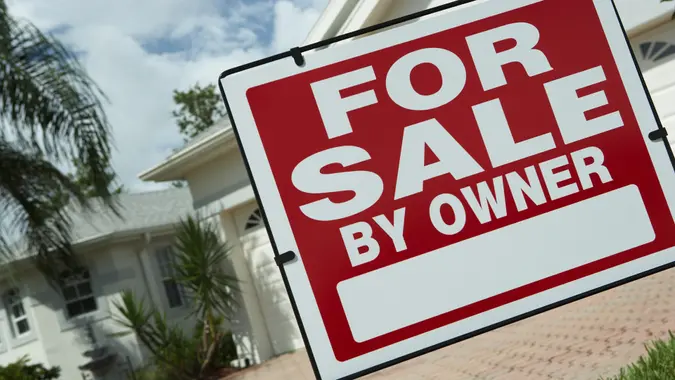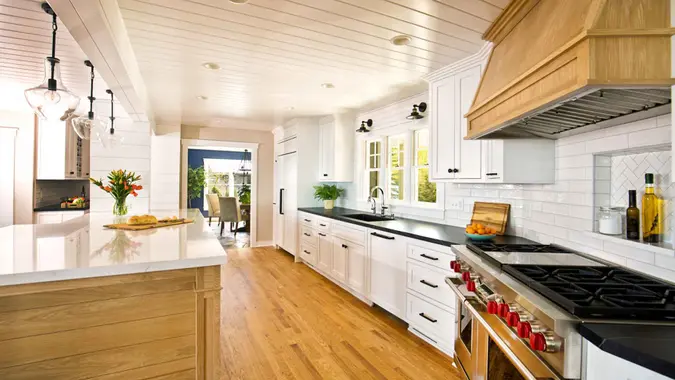How Much You Should Really Be Spending On Rent in 2025 Based on Your Income Bracket

Commitment to Our Readers
GOBankingRates' editorial team is committed to bringing you unbiased reviews and information. We use data-driven methodologies to evaluate financial products and services - our reviews and ratings are not influenced by advertisers. You can read more about our editorial guidelines and our products and services review methodology.

20 Years
Helping You Live Richer

Reviewed
by Experts

Trusted by
Millions of Readers
Rent is one of those areas that is getting significantly more expensive, especially in key metropolitan areas and big cities.
So, naturally, you should wonder how much you should spend on rent. Now, this varies from person to person by income.
If you consider yourself part of the middle class, the average household income is $80,610, according to the U.S. Census Bureau. The average individual income is about $62,088, based on the latest data from Fidelity.
However, generally speaking, people are paid more in big cities. For example, in New York, full-time workers earned a median of $70,295 in 2023, according to the U.S. Census Bureau.
So, everyone makes a little different money, so how do you determine how much to spend on rent?
Let’s dig into it.
The 30% Rule for How Much You Should Spend on Rent
This is the oldest rule when it comes to what to spend on rent: No more than 30% of your income.
Now, the 30% rule works in states, cities, and towns where rental prices are in line with median average earnings. However, Zillow data shows that the average New York City studio currently rents for $3,414 a month.
That would mean most won’t be able to afford to live in the average studio in NYC, since you would need to make over $11,000 per month to do so. So, you may have to opt for a less desirable apartment or live in another neighborhood outside the city that’s more affordable.
On the other hand, cities like Phoenix or Houston have an average rent of just around $1,000, which would allow practically any average earner and especially any household to afford rent in those areas easily.
Based on Zillow’s top rental markets data, the average person can comfortably fit into the 30% bracket in the following markets (prices are for 1-bed apartments or condos):
- Houston, TX: $1,150
- Phoenix, AZ: $1,209
- Chicago, IL: $1,542
- Orlando, FL: $1,391
- Atlanta, GA: $1,437
If we break this down depending on income brackets, here is what 30% looks like (using a median amount):
- Low income ($2- 3k/monthly): ~$750 (30% of $2.5k)
- $3-4k/monthly: ~$1,050
- $4-5k/monthly: ~$1,500
- $5-6k/monthly: ~$1,650
- $6-7k/monthly: ~$1,950
- $8-9k/monthly: ~$2,400
- $9-10k/monthly: ~$2,850
If you’re an average earner, making just over $5,000 per month, you should aim to spend under $1,650 per month on rent.
If you can spend less than 30% by living in a more affordable area, then this is worth doing to give yourself greater financial flexibility and security.
Looking Ahead: 50% / 30% / 20% Rule
Remember, your income is the guiding factor, regardless of the “rule” you follow.
Another way to divide what you earn is:
- 50% on living costs, including rent
- 30% on living, doing fun things, shopping, eating out, and holidays
- 20% on saving and investing, to use this money to buy a property and get out of rentals.
3 Key Factors That Influence Rental Costs
Location
Location can and will always make a huge difference when it comes to rental prices. Some cities are more expensive than others, even when comparing similar-sized properties.
The same is true of areas within cities, towns, and even rural communities. Some are more desirable than others, and therefore, more expensive in areas where there are more owners and fewer rental properties, which will also push the price up.
Property Size
Naturally, the more space (bedrooms, especially) that you need, the more a house will cost.
For example, in those more affordable markets we listed above, this is the Zillow average price for 3-bedroom houses:
- Chicago, IL: $2,500
- Houston, TX: $2,101
- Phoenix, AZ: $2,275
- Orlando, FL: $2,400
- Atlanta, GA: $2,179
Market Trends
As a concept, we trust the market, but it’s hard to know whether it’s going up or down.
Rental prices are like that. Prices move up and down for numerous reasons, like interest rates going up or a residential area improving. They can also go down if an area experiences a decline or interest rates decrease (if a landlord passes along any cost savings).
Supply and demand are also big factors, and there can even be seasonal variations in pricing. Thanks to Zillow and other data-driven platforms, it’s easier to see when and why prices move, and you can use this to potentially predict which areas will get cheaper or more expensive over time.
 Written by
Written by  Edited by
Edited by 

























